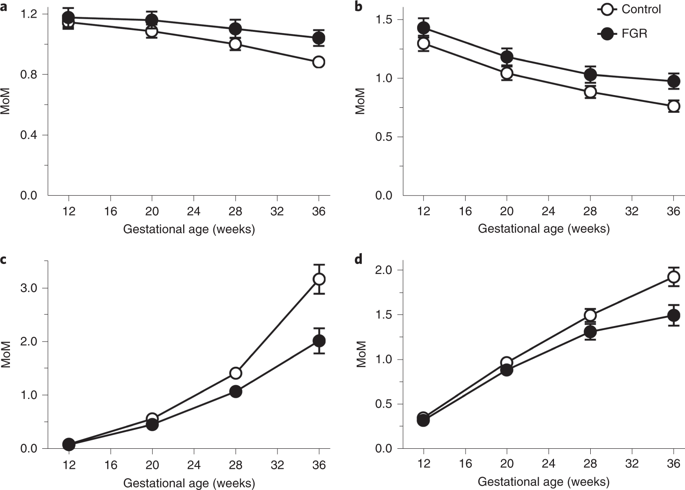Nature Medicine ( IF 58.7 ) Pub Date : 2020-03-11 , DOI: 10.1038/s41591-020-0804-9 Ulla Sovio 1, 2 , Neil Goulding 3, 4, 5 , Nancy McBride 3, 4, 5 , Emma Cook 1 , Francesca Gaccioli 1, 2 , D Stephen Charnock-Jones 1, 2 , Debbie A Lawlor 3, 4, 5 , Gordon C S Smith 1, 2

|
Fetal growth restriction (FGR) is the major single cause of stillbirth1 and is also associated with neonatal morbidity and mortality2,3, impaired health and educational achievement in childhood4,5 and with a range of diseases in later life6. Effective screening and intervention for FGR is an unmet clinical need. Here, we performed ultrahigh performance liquid chromatography–tandem mass spectroscopy (UPLC–MS/MS) metabolomics on maternal serum at 12, 20 and 28 weeks of gestational age (wkGA) using 175 cases of term FGR and 299 controls from the Pregnancy Outcome Prediction (POP) study, conducted in Cambridge, UK, to identify predictive metabolites. Internal validation using 36 wkGA samples demonstrated that a ratio of the products of the relative concentrations of two positively associated metabolites (1-(1-enyl-stearoyl)-2-oleoyl-GPC (P-18:0/18:1) and 1,5-anhydroglucitol) to the product of the relative concentrations of two negatively associated metabolites (5α-androstan-3α,17α-diol disulfate and N1,N12-diacetylspermine) predicted FGR at term. The ratio had approximately double the discrimination as compared to a previously developed angiogenic biomarker7, the soluble fms-like tyrosine kinase 1:placental growth factor (sFLT1:PlGF) ratio (AUC 0.78 versus 0.64, P = 0.0001). We validated the predictive performance of the metabolite ratio in two sub-samples of a demographically dissimilar cohort, Born in Bradford (BiB), conducted in Bradford, UK (P = 0.0002). Screening and intervention using this metabolite ratio in conjunction with ultrasonic imaging at around 36 wkGA could plausibly prevent adverse events through enhanced fetal monitoring and targeted induction of labor.
中文翻译:

母体血清代谢物比率可预测足月胎儿生长受限
胎儿生长受限 (FGR) 是死产1的主要单一原因,还与新生儿发病率和死亡率2,3、儿童时期的健康和教育成就受损4,5以及晚年的一系列疾病有关6. FGR 的有效筛查和干预是未满足的临床需求。在这里,我们使用来自妊娠结局预测的 175 例足月 FGR 和 299 例对照对 12、20 和 28 周胎龄 (wkGA) 的母体血清进行了超高效液相色谱-串联质谱 (UPLC-MS/MS) 代谢组学(POP)研究,在英国剑桥进行,以确定预测性代谢物。使用 36 个 wkGA 样本的内部验证表明,两种正相关代谢物 (1-(1-enyl-stearoyl)-2-oleoyl-GPC (P-18:0/18:1) 和1,5-脱水葡萄糖醇)与两种负相关代谢物(5α-androstan-3α,17α-diol disulfate 和N 1, N12-二乙酰精胺)预测足月的 FGR。与先前开发的血管生成生物标志物7相比,该比率具有大约两倍的辨别力,即可溶性 fms 样酪氨酸激酶 1:胎盘生长因子 (sFLT1:PlGF) 比率(AUC 0.78 对 0.64,P = 0.0001)。我们在英国布拉德福德 (Bradford) 进行的人口统计学上不同的队列出生于布拉德福德 (BiB) 的两个子样本中验证了代谢物比率的预测性能 ( P = 0.0002)。在 36 wkGA 左右使用这种代谢物比率进行筛查和干预,结合超声成像,可以通过加强胎儿监测和有针对性的引产来合理地预防不良事件。











































 京公网安备 11010802027423号
京公网安备 11010802027423号